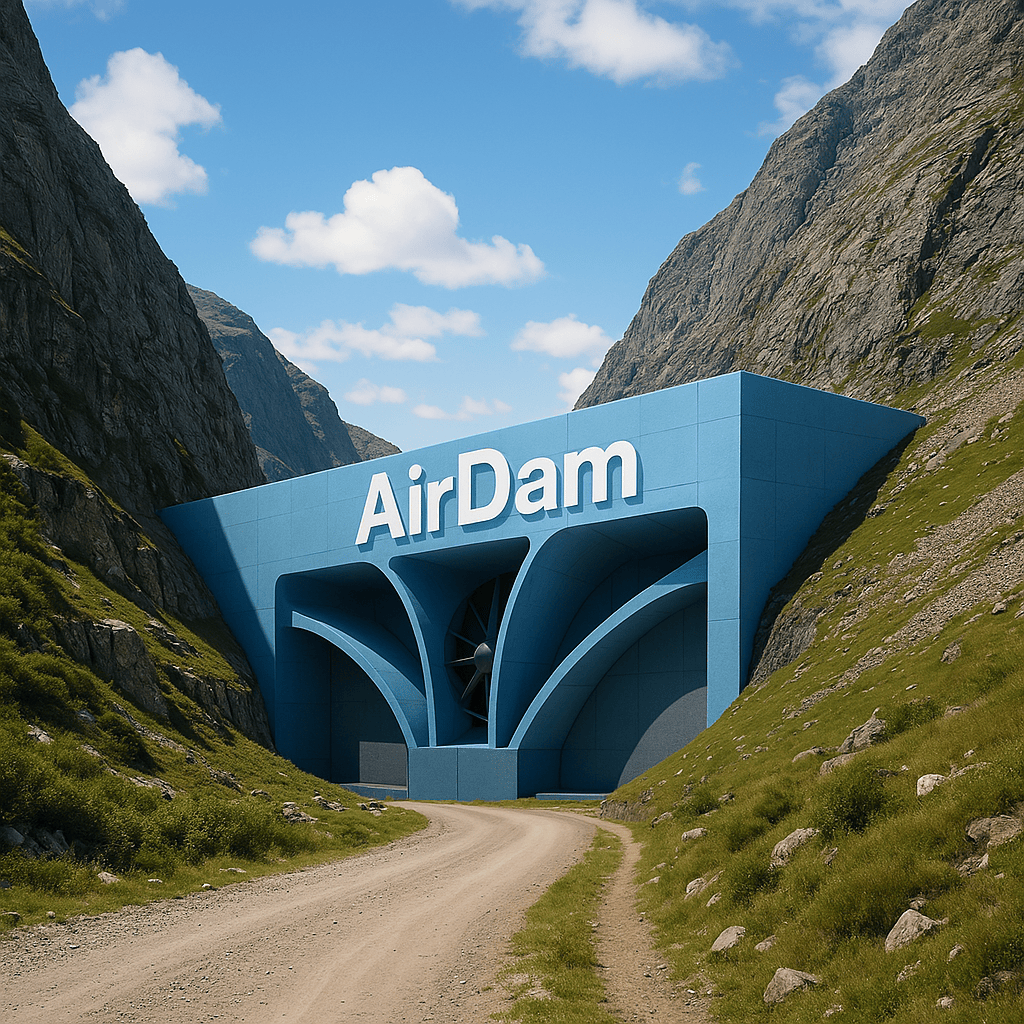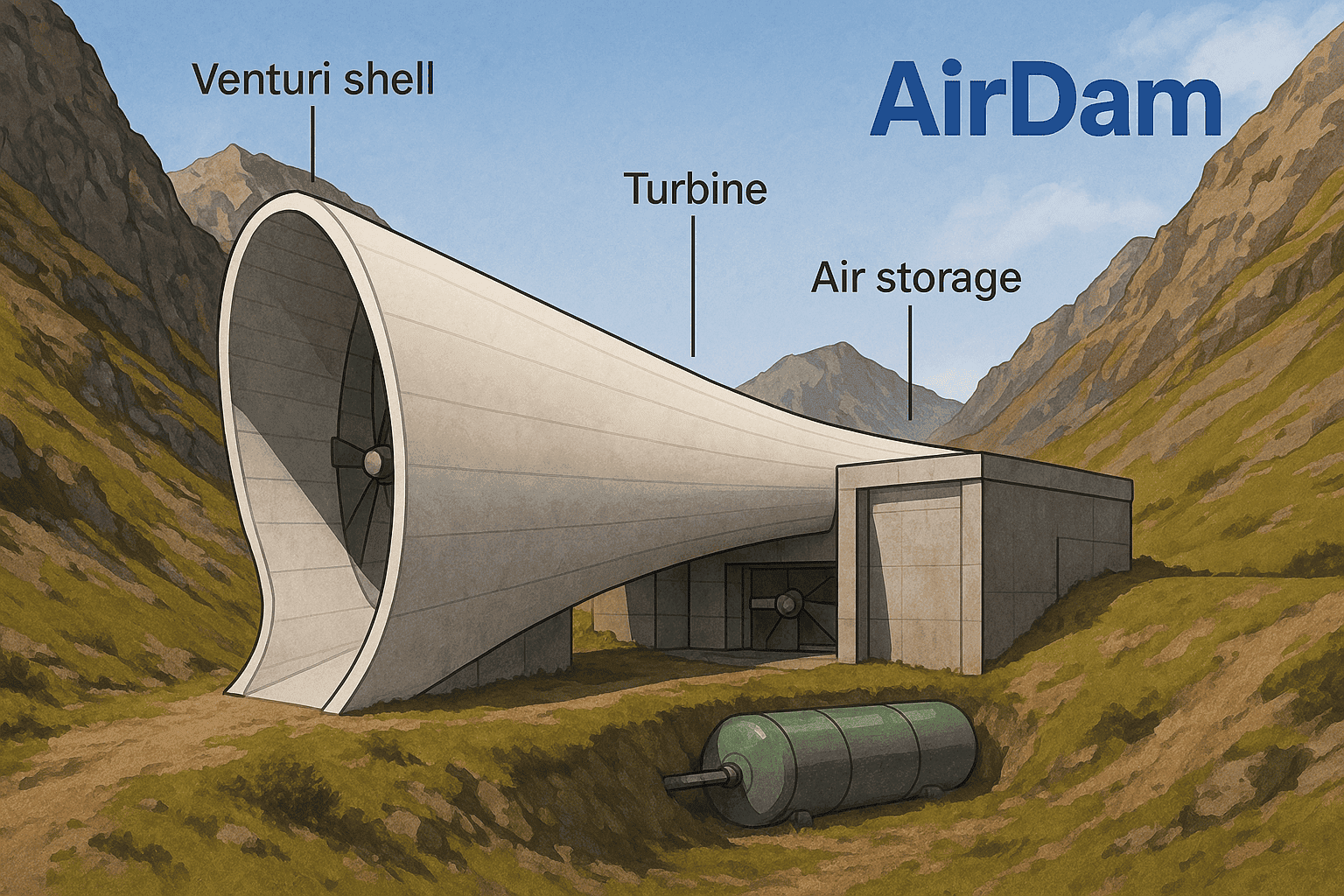AirDam: The Wind Energy Innovation That's Shaping the Future of Renewable Power
Patent Pending
GreyArray Skunk Works | Published:
What is AirDam?
 AirDam is a terrain-integrated wind energy system designed to maximize wind energy production in areas that are traditionally difficult to harness for conventional wind turbines. By utilizing the natural geography of mountain passes and narrow valleys, AirDam amplifies wind flow using the Venturi effect—a phenomenon where wind is funneled and accelerated through narrow passages.
AirDam is a terrain-integrated wind energy system designed to maximize wind energy production in areas that are traditionally difficult to harness for conventional wind turbines. By utilizing the natural geography of mountain passes and narrow valleys, AirDam amplifies wind flow using the Venturi effect—a phenomenon where wind is funneled and accelerated through narrow passages.
Unlike traditional wind farms that rely on open, flat landscapes, AirDam targets natural wind choke points, such as mountain passes, where air is naturally funneled and accelerated. This approach allows for the generation of renewable energy in locations where typical wind turbines would struggle to be effective.
The Problem with Traditional Wind Farms
The primary challenge with conventional wind energy production is location. Wind farms are often placed in areas with consistent, moderate wind speeds. However, finding vast stretches of open land where winds are reliably strong enough to justify the installation of turbines can be difficult and costly.
Moreover, wind farms often face aesthetic concerns, land use issues, and environmental impact. In many regions, there are physical, geographical, and legal barriers to large-scale wind installations. These limitations have led to an ongoing search for alternative methods of wind energy production—AirDam could be the breakthrough the industry has been waiting for.
How AirDam Works
AirDam’s design takes advantage of topographic features like mountain passes and narrow valleys, which naturally increase wind speed as air is funneled through these constricted spaces. Here's how the system works:
1. Wind Funnel
 At the heart of the AirDam system is a structural funnel that channels wind into a narrow, high-pressure zone. These funnels are designed to mimic the Venturi effect, which is commonly seen in fluid dynamics. As air passes through the narrow funnel, its speed increases, amplifying its power.
At the heart of the AirDam system is a structural funnel that channels wind into a narrow, high-pressure zone. These funnels are designed to mimic the Venturi effect, which is commonly seen in fluid dynamics. As air passes through the narrow funnel, its speed increases, amplifying its power.
2. Turbine Integration
Once the wind is accelerated, it enters a turbine chamber where high-efficiency wind turbines capture the increased energy. These turbines can be horizontal-axis or vertical-axis, depending on the needs of the location. The turbines are strategically positioned in alignment with the direction of the compressed wind, maximizing energy capture.
3. Compressed Air Storage
Excess wind energy is stored in compressed air storage tanks, which allows for power to be utilized even when the wind isn’t blowing at full force. This system mimics traditional hydroelectric pumped storage, but instead of using water, it stores energy as compressed air. This ensures a stable and reliable energy output, even during periods of low wind.
4. Modular and Scalable Design
AirDam’s design is modular, meaning it can be expanded or adapted to different environments. Whether you're looking to power a small off-grid community or a large industrial complex, AirDam can be scaled to meet specific energy needs. The modular nature of the system also ensures that it can be deployed in a variety of geographical settings, including remote, hard-to-reach areas.
Key Advantages of AirDam
AirDam offers a multitude of advantages over traditional wind farms and other renewable energy technologies. Here are a few of the standout benefits:
1. Efficiency in Challenging Locations
By using natural wind funnels, AirDam can generate significant amounts of power even in regions where traditional wind turbines would be inefficient. Mountain passes, valleys, and other constricted landscapes are perfect for AirDam’s system, making renewable energy production possible in areas previously deemed unsuitable.
2. Minimal Land Use
Unlike conventional wind farms that require vast expanses of land, AirDam can be installed in narrow mountain passes, where the physical space is minimal. This minimizes the environmental impact, reduces the footprint, and allows for the preservation of valuable land for agriculture or natural habitats.
3. Cost-Effective and Scalable
AirDam’s modular design makes it cost-effective for both large-scale and small-scale installations. The system can be implemented in stages, which allows for flexible funding and scalability. Once the initial setup is complete, the system’s efficiency ensures a quick return on investment.
4. Resilient to Weather Variability
One of the most unique aspects of AirDam is its ability to buffer energy by storing it in compressed air storage tanks. This makes it resilient to variations in wind speeds, ensuring a stable and reliable energy source even during windless periods.
5. Sustainable and Eco-Friendly
The system runs entirely on renewable energy, with no harmful emissions or environmental degradation. The compressed air storage system also prevents any risk of pollution, making AirDam a truly green energy solution.
Applications for AirDam
AirDam is an adaptable and versatile energy solution that can be applied in a variety of settings:
1. Remote Off-Grid Locations
For communities and industries in remote or rural areas, AirDam can provide a reliable source of energy without the need for extensive infrastructure or grid connection. This is particularly valuable in areas where electricity access is limited or non-existent.
2. Military and Industrial Use
AirDam's efficient and scalable design makes it an ideal solution for military installations, research facilities, and other remote industrial applications. Its ability to store energy for later use provides an essential backup for critical operations that require consistent power.
3. Hybrid Systems with Solar or Geothermal Energy
AirDam can also be integrated into hybrid renewable energy systems, combining wind power with solar or geothermal energy sources. This can provide a more reliable and constant energy supply, particularly in regions with fluctuating wind conditions.
4. Disaster-Resilient Energy Systems
In areas affected by natural disasters, AirDam’s modular and decentralized nature makes it ideal for disaster recovery. The system can be quickly deployed to provide emergency power for essential services such as hospitals, water treatment plants, and emergency shelters.
The Future of AirDam
With its patent-pending status, AirDam represents the future of sustainable, off-grid energy generation. As the technology continues to develop, we anticipate that AirDam will play a critical role in reshaping the energy landscape, providing cleaner, more efficient power solutions to a wide range of industries.
The potential for global deployment is enormous—especially in remote or difficult-to-access areas where traditional power systems are costly or impractical. The system’s ability to harness natural wind flows, combined with its innovative storage capabilities, positions AirDam as a true game-changer in the field of renewable energy.
Conclusion: A Bold Step Toward a Greener Future
AirDam is more than just a wind turbine—it’s a new paradigm in renewable energy. By taking advantage of natural landscapes to maximize wind power efficiency, AirDam offers a solution that is both sustainable and scalable. As the world moves toward cleaner energy solutions, AirDam is poised to lead the charge in providing reliable, green energy to the most challenging environments.
Stay tuned as the AirDam patent progresses through the USPTO. We will continue to update you on new developments, prototypes, and potential partnerships. Join us in the journey to revolutionize energy production and help us shape a cleaner, greener world.